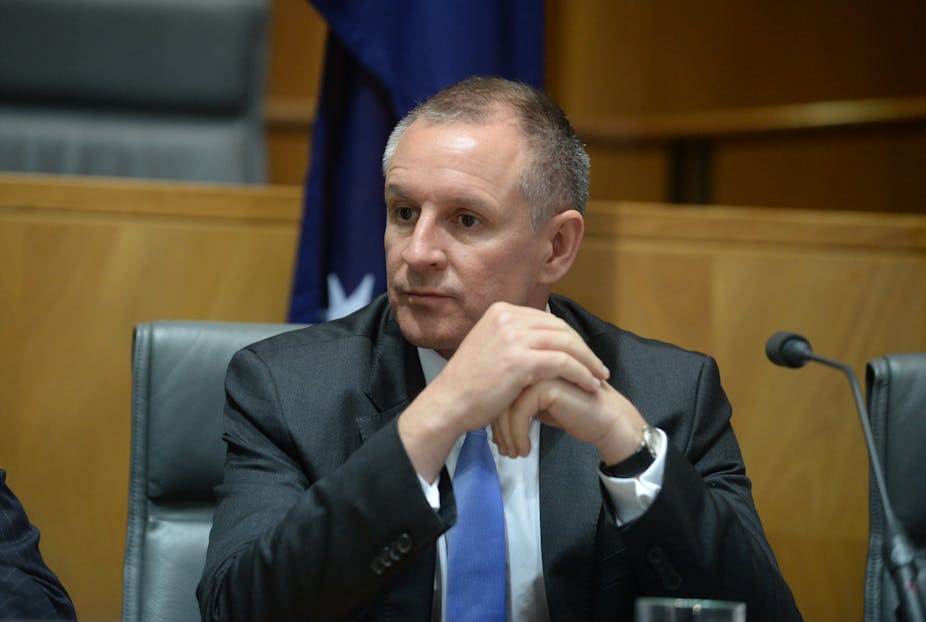The draft terms of reference for South Australia’s planned Royal Commission on the nuclear industry, which are open for public consultation until the end of next week, are deliberately broad.
When announcing the commission last month, SA Premier Jay Weatherill said it would “explore the opportunities and risks of South Australia’s involvement in the mining, enrichment, energy and storage phases for the peaceful use of nuclear energy”.
The move caught many by surprise, not least federal opposition leader Bill Shorten, who – unlike his Labor colleague Weatherill – remains opposed to nuclear.
The announcement also generated huge amounts of free PR for the nuclear industry, as shown in the avalanche of media coverage that ensued – some deliberately balanced, some sceptical of the commission and its value, but much of it highly favourable, especially in the business press.
It is not hard to see why. As Naomi Klein contends, nuclear power is an industrial technology, organised in a corporate manner. And as psychiatrist Robert Jay Lifton points out, no technology does more to underline humanity’s dominion over nature than our ability to split the atom.
The positive spin
Reflecting this hubris, the Australian Financial Review (AFR) has dedicated no fewer than 15 editorials and columns to favourable coverage of Weatherill’s plan. They have focused on the economics of nuclear power and SA’s uranium reserves, the safety of small modular nuclear reactors, the economic opportunities of waste management, and the possibility of an objective and non-politicised debate about the nuclear industry.
Yet this narrow focus on finance and science (themselves live areas of debate) is wholly unsatisfactory for discussing the nuclear industry. Also relevant are history, ethics, politics, and the perspectives of people who will be directly affected by any decisions made. A Royal Commission (or a media debate, for that matter) that ignores these factors is insufficient.
Politically, I find it hard to imagine that nuclear power is a serious option for Australia, despite being included in the commission’s terms of reference. Weatherill recognises this and has already said that it is unlikely.
I do not doubt that the nuclear power true believers profiled in the AFR are sincere, or that industry could make a concerted push for nuclear power. For example, one could imagine a campaign to replace Port Augusta’s decommissioned Playford power station with a small modular reactor, rather than the solar thermal plant some have suggested. (Sam Johnson, the mayor of Port Augusta, opposes such a move.)
But it all sounds rather unlikely and, as environmentalists such as Ian Lowe have noted, nuclear makes it more difficult to “move to the sort of sustainable, ecologically healthy future that should be our goal.”
The real motive
What the Royal Commission’s broad terms of reference really do is give Weatherill flexibility, while also diluting oppositional voices. The anti-nuclear movement is, relative to industry, very small and under-resourced. To what aspect of the inquiry ought they dedicate their energy? If one area is prioritised, do they concede another?
Some observers, among them Greens senator Scott Ludlam, contend that the long game for the government is another attempt to build a radioactive waste dump in the state’s outback. Set against the remote chances of Australia embracing nuclear power, or the unfavourable international economics of uranium enrichment, waste storage stands as more of a genuinely live possibility.
Former Australian Nuclear Science and Technology Organisation chair Ziggy Switkowski has commented favourably on SA’s “benign and sparsely populated geology”. And a 2012 state cabinet document had already proposed establishing an “outback” waste-storage facility to “pay off debt and establish an infrastructure fund.”
Understood in this context, the Royal Commission is not about nuclear power. It is another attempt to establish a waste-dump in South Australia. Here we must consider history.
Lessons from history
In February 1998, the Howard federal government announced plans to build a national radioactive waste facility in South Australia. Billa Kalina, a 67,000 sq km region in the arid north, was eventually selected as the preferred site. The plan was defeated after a six-year federal campaign.
One media narrative, as espoused in the AFR, is that this defeat was the result of a revolt by SA politicians. But this version of the story ignores the powerful campaign led by the Kupa Piti Kungka Tjuta, the senior aboriginal women’s council of Coober Pedy.
This story has been recorded by movement researchers Nina Brown and Sam Sowerwine and in a book, Talking Straight Out: Stories from the Irati Wanti Campaign.
Many members of the Kunga-Tjuta were survivors of the British government’s atomic testing in the 1950s and 60s, and so understood the devastating history of the nuclear industry. Upon hearing about the waste dump proposal, the group issued this statement:
We are the Aboriginal Women. Yankunytjatjara, Antikarinya and Kokatha. We know the country. The poison the Government is talking about will poison the land. We say, “No radioactive dump in our ngura – in our country. It’s strictly poison, we don’t want it.
The traditional residents of this supposedly "benign and sparsely populated geology” fought hard to protect their country using the tools they had available. They explained, demanded, marched and sang. They worked with green activists and wrote passionate letters. They urged politicians to “get your ears out of your pockets”. They won.
As South Australia faces another push from the nuclear industry, we would do well to remind ourselves of these stories. To paraphrase the late historian Howard Zinn, we need to emphasise what is possible by remembering those moments in our recent history when people demonstrated their capacity to resist, come together, and occasionally, to win.

